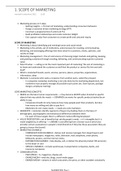Samenvatting
COMPLETE SUMMARY A Framework for Marketing Management, Global Edition, ISBN: 9781292093147 Marketing (6012B0420Y)
- Vak
- Instelling
- Boek
I got a 8.5 just by studying on this one! Complete summary of: A Framework for Marketing Management, Global Edition, 6th Edition, Philip Kotler, Kevin Lane Keller; ©2016|Pearson, 352 pages, Print ISBN-13: 3147 eText ISBN: 3154 Perfect for the Marketing course at University of Amsterdam
[Meer zien]





